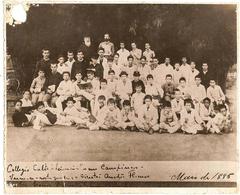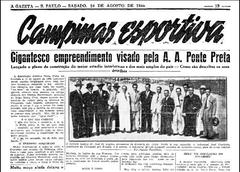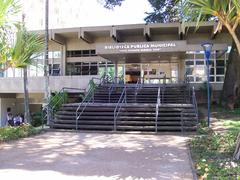Casa do Sol Campinas, Brazil: Visiting Hours, Tickets, and Historical Sites Guide
Date: 04/07/2025
Introduction: Casa do Sol – Campinas’ Literary and Cultural Landmark
Casa do Sol, nestled in the culturally vibrant city of Campinas, São Paulo, is a celebrated beacon of Brazil’s literary and architectural heritage. Founded in the late 1960s by the pioneering writer Hilda Hilst, Casa do Sol is more than a residence—it is a sanctuary for creative minds and a testament to Campinas’ rich historical landscape. The estate, built on land formerly part of the historic Fazenda São José, seamlessly melds tradition with modern cultural relevance. Today, Casa do Sol stands as a protected heritage site, inviting visitors to explore its unique architecture, lush gardens, and the enduring intellectual legacy of Hilda Hilst and her contemporaries (pt.wikipedia.org, campinas.com.br, Latin American Literature Today).
Table of Contents
- Early Settlement and Historical Context
- Emergence of Coffee Plantations and Cultural Estates
- The Making of Casa do Sol and Its Intellectual Role
- Architectural and Cultural Significance
- Visitor Information: Hours, Tickets, and Accessibility
- Nearby Attractions and Travel Tips
- Visual Media and Virtual Resources
- Frequently Asked Questions (FAQ)
- Casa do Sol’s Role in Campinas’ Heritage
- Summary and Recommendations
- References
Early Settlement and Historical Context
The region now known as Campinas has been inhabited for thousands of years, with archaeological discoveries at sites like Morro Azul indicating human presence between 11,000 and 7,000 years ago (pt.wikipedia.org). By the 18th century, the area had become a strategic stop for caravans and “tropeiros” (cattle drivers) traversing São Paulo state. The name “Campinas,” meaning “fields,” reflects the open, fertile landscapes that attracted early settlers. Officially founded in 1774, Campinas rapidly developed as a center for agriculture—first sugarcane, then coffee—laying the groundwork for the estates that would later shape its cultural identity.
Emergence of Coffee Plantations and Cultural Estates
Campinas’ 19th-century prosperity was driven by expansive coffee, cotton, and sugarcane plantations. The 1867 arrival of the railway linked Campinas to São Paulo and Santos, boosting economic and social activity. Iconic estates like Casa Grande e Tulha became both economic engines and cultural meeting places, hosting intellectuals and artists (pt.wikipedia.org). Casa do Sol, built much later, is rooted in this tradition—its land, once part of Fazenda São José, connects Hilst’s home to the broader narrative of Campinas’ evolving rural and cultural landscape (campinas.com.br).
The Making of Casa do Sol and Its Intellectual Role
Constructed in the 1960s by Hilda Hilst, Casa do Sol was conceived as both a private retreat and a communal space for creativity. Inspired by monastic architecture, the house features a central courtyard framed by arches, a wide veranda, and a sprawling garden centered around a centuries-old fig tree (portal.sescsp.org.br). Casa do Sol quickly became an intellectual hub, attracting artists, writers, and scientists—including Lygia Fagundes Telles, Caio Fernando Abreu, José Antônio de Almeida Prado, and physicists César Lattes and Mario Schenberg.
Within these walls, Hilst produced much of her poetic, fictional, and theatrical work, exploring themes of love, existence, and the divine (Latin American Literature Today). The house’s décor is eclectically spiritual, with religious icons, artworks, and books gifted by friends and collaborators.
Architectural and Cultural Significance
Casa do Sol’s architecture is a harmonious blend of regional tradition and Hilst’s visionary ideals. The monastic layout encourages both introspection and community, while the gardens and verandas foster a deep connection with nature (portal.sescsp.org.br). In 2011, Casa do Sol was designated a protected heritage site by Campinas’ cultural council (Condepacc), ensuring the preservation of its 700 m² building, gardens, and original furnishings (campinas.com.br). Any alterations require special authorization, safeguarding the estate’s historical and cultural integrity.
Visitor Information: Hours, Tickets, and Accessibility
- Hours: Tuesday to Sunday, 10:00 AM–5:00 PM. Closed Mondays and public holidays.
- Tickets: Standard entry is around R$20–R$50. Discounts available for students, seniors, and children; under 12s often enter free. Special programs (e.g., overnight stays) and events may have different pricing (Veja SP).
- Guided Tours: Available by appointment, with tours in Portuguese and, by request, in English or Spanish.
- Accessibility: Main areas are equipped with ramps and accessible restrooms, but some historic sections have limited access. Contact ahead for specific needs.
- Booking: Advance reservations are highly recommended, especially for guided tours, group visits, or overnight programs. Book via the Instituto Hilda Hilst’s official website or contact form (campinas.com.br).
- Photography: Permitted in most public spaces, though flash and tripods are generally prohibited.
- Getting There: Casa do Sol is about 10–15 km from Campinas city center. Access is best by car or taxi; public transport options are limited.
Nearby Attractions and Travel Tips
Enhance your visit by exploring nearby Campinas cultural sites:
- Museu de Arte Contemporânea de Campinas (MACC): Features over 3,000 contemporary works.
- Bosque dos Jequitibás: Urban park with trails and a small zoo.
- Parque Portugal (Taquaral): Offers lakes, sports, and green space.
- Historic Downtown: Noted for architecture, theaters, and cafés.
- Cambuí Neighborhood: Renowned for restaurants, nightlife, and cultural venues.
Tip: Campinas’ mild climate makes it a year-round destination. For ease of transport, consider renting a car or using ride-hailing services.
Visual Media and Virtual Resources
- High-quality images of Casa do Sol’s interiors, gardens, and events are available on the Instituto Hilda Hilst’s website and cultural portals.
- Alt text examples: “Casa do Sol veranda beneath fig tree,” “Interior arches and courtyard of Casa do Sol.”
- Interactive maps and occasional virtual tours enable remote exploration.
Frequently Asked Questions (FAQ)
Q: What are Casa do Sol’s visiting hours?
A: Tuesday to Sunday, 10:00 AM–5:00 PM. Closed Mondays and holidays.
Q: How do I purchase tickets?
A: Tickets are available on-site or can be booked via the official website. Advance booking is recommended.
Q: Is Casa do Sol accessible to visitors with disabilities?
A: Most main areas are accessible, though some historic sections may be challenging. Contact in advance for arrangements.
Q: Are guided tours available in English?
A: Tours are primarily in Portuguese, but English or Spanish options may be arranged with prior notice.
Q: Can I take photographs inside Casa do Sol?
A: Yes, but flash and tripods are restricted in some areas.
Casa do Sol’s Role in Campinas’ Heritage
Casa do Sol is inseparable from Campinas’ transformation—from a colonial outpost to a thriving agricultural and cultural center (artsandculture.google.com). The estate embodies the transition of rural mansions into spaces for artistic and intellectual exchange. Its preservation not only honors Hilst’s legacy but also affirms Campinas’ ongoing commitment to cultural and literary innovation.
Summary and Recommendations
Casa do Sol is a vital link between Campinas’ past and present, fusing literary history, distinctive architecture, and communal spirit. As Hilda Hilst’s former home and a creative retreat for some of Brazil’s most acclaimed thinkers, it offers a unique, immersive experience for visitors. Plan ahead, book your tickets, and consider joining a guided tour or special event to fully appreciate this remarkable site. Pair your visit with other cultural attractions in Campinas for a rich and memorable journey into the heart of Brazilian creativity (campinas.com.br, Veja SP, Latin American Literature Today).
References and Further Reading
- História de Campinas – Wikipedia
- Instituto Hilda Hilst – Campinas.com.br
- Three Poems of Death: Minimal Odes by Hilda Hilst – Latin American Literature Today
- Casa de Hilda Hilst é aberta para visitas – Veja SP
- Campinas Cultural Heritage – Google Arts & Culture





